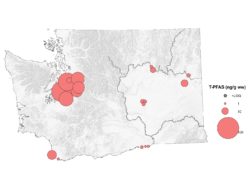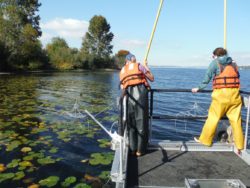Callie Mathieu and Siana Wong, Washington State Department of Ecology
Per- and poly-fluoroalkyl substances (PFAS) are a large group of man-made chemicals used in many industrial and consumer products, such as those with non-stick or stain-proof coatings, and fire-fighting foams. PFAS have been manufactured since the 1950s, but manufacturers began phasing out certain compounds – like perfluorooctane sulfonate (PFOS) and perfluorooctanoic acid (PFOA) – in the 2000s due to concern over their toxicity and persistence in humans and the environment. PFAS are released to the environment through manufacturing emissions and through the use or disposal of products containing PFAS. As a result of these releases, PFAS are widespread in the environment and some compounds, like PFOS, build up in aquatic food webs leading to elevated concentrations in predator fish species.
In 2008, the Washington State Department of Ecology carried out statewide testing of PFAS in rivers and lakes to determine their occurrence in freshwater systems. That survey showed widespread presence of PFAS in surface waters, fish tissue, and osprey eggs throughout Washington State, at concentrations consistent with other non-point source waterbodies in North America. We conducted another statewide survey in 2016 to see if concentrations had changed since the first round of sampling, following shifts in manufacturing. The 2016 results showed a general decrease in detection frequencies and concentrations of PFAS in surface water samples compared to 2008, but no change was apparent in freshwater fish tissue or osprey eggs.

Figure 1. Total (summed) per- and poly-fluoroalkyl substance (PFAS) concentrations in freshwater fish fillet composite samples collected in 2016.
In both studies, the highest PFAS concentrations observed across the state came from urban lakes sampled in Western Washington (Figure 1). Surface waters from the urban lakes displayed distinct compound profiles from other waterbodies. The urban lakes contained a higher relative percent contribution of PFOS, which is highly bio-accumulative. Fillet and liver tissues of freshwater fish collected from the urban lakes contained PFOS concentrations of 4.8 – 74.2 ng/g wet weight (ww) and 23.2 – 336 ng/g ww, respectively. The highest osprey egg PFOS concentration (675 ng/g fresh weight) was found at Lake Washington, as well. PFOS was the dominant compound found in all biota samples, making up 60-100% of the total PFAS burden.
As a follow-up to these previous PFAS sampling efforts, Ecology plans to conduct a study to characterize sources of PFOS and other PFAS to Lake Washington in 2020-2022. The study will be completed in two phases: Phase 1 will focus on characterizing PFAS contaminant pathways in the Lake Washington watershed, while Phase 2 will focus on prioritizing and identifying potential sources to the lake. As part of the initial characterization in Phase 1, we will collect PFAS samples from Lake Washington, tributaries to the lake, stormwater, and precipitation as bulk atmospheric deposition. Phase 1 sampling is scheduled to begin in summer 2020. The ultimate goals of the study are to be able to find and reduce external sources of PFAS to the lake, as well as apply what is learned to other urban waterbodies in Washington with PFAS contamination.










